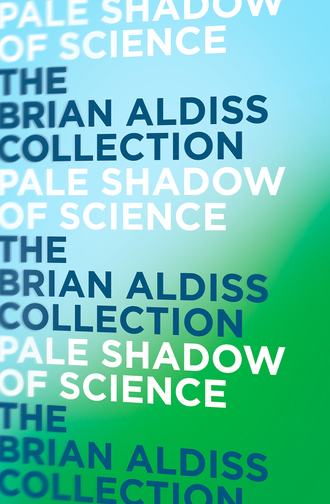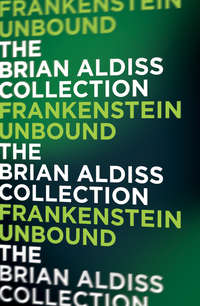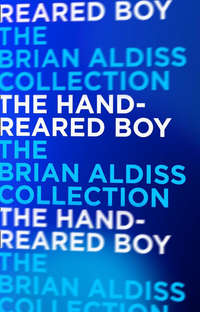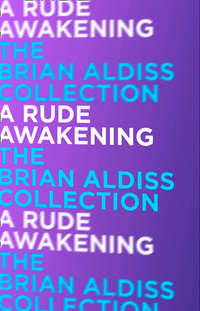
Полная версия
Pale Shadow of Science

The Pale Shadow of Science
BY BRIAN ALDISS

Contents
Title Page
Introductory Note
Introductory Note to The Lurid Glare of the Comet
Preparation for What?
Long Cut to Burma
Old Bessie
Science Fiction’s Mother Figure
The Immanent Will Returns
The Downward Journey: Orwell’s 1984
A Whole New Can of Worms
Peep
A Transatlantic Harrison, Yippee!
The Atheist’s Tragedy Revisited
The Pale Shadow of Science
A Monster for All Seasons
Helliconia: How and Why
Bold Towers, Shadowed Streets …
… And the Lurid Glare of the Comet
When the Future Had to Stop
What Happens Next?
Grounded in Stellar Art
It Takes Two to Tango
Robert Sheckley’s World: Australia
Sturgeon: Mercury Plus X
The Glass Forest
About the Author
Also available by the author
Also part of The Brian Aldiss Collection
Copyright
About the Publisher
Introductory Note
This book preserves a few of the many articles and reviews I have written over the last few years. My passport describes me as ‘Writer and Critic,’ because a fair proportion of my writing has always been non-fiction. Non-fiction has a role to play in an author’s life. It is to fiction what target practice is to a soldier: it keeps his eye in in preparation for the real thing.
For the record, these are the various places where the pieces originally appeared.
‘Preparation for What?’ in The Fiction Magazine, 1983; ‘Long Cut to Burma’ (as ‘Drawn Towards Burma’) in The Fiction Magazine, 1982, here revised; ‘Old Bessie’ first told at a Halloween party in Chris Priest’s house in Harrow, October 1984.
‘Science Fiction’s Mother Figure’ (as ‘Mary Wollstonecraft Shelley’) in Science Fiction Writers, edited by E.F. Bleiler, Simon & Schuster, 1981; ‘The Immanent Will Returns’ (as ‘Olaf Stapledon’) in the Times Literary Supplement, 1983; ‘The Downward Journey’ in Extrapolation, 1984; ‘A Whole New Can of Worms’ originated in a speech delivered at the City Lit on 9 January 1982, later published in Foundation, 1982; ‘Peep’ formed the Introduction to James Blish’s Quincunx of Time, published by Avon Books, 1983; ‘A Transatlantic Harrison, Yippee!’ was printed in the programme book for Novacon 12, held in Birmingham, England in 1982.
‘The Atheist’s Tragedy Revisited’ is a new piece. ‘The Pale Shadow of Science’ was delivered as a talk to the British Association for the Advancement of Science during their annual meeting at Norwich, 11 September 1984, and an abridged edition was published in The Guardian newspaper, 13 September 1984; ‘A Monster for All Seasons’ in Science Fiction Dialogues, edited by Gary Wolfe, Academy Press, 1982; ‘Helliconia: How and Why’ has not yet been published anywhere.
My thanks go to the committee of Norwescon 8, to all my friends attending that illustrious event, and in particular to Jerry Kaufman, Donald G. Keller, and Serconia Press.
This volume is divided into three sections, autobiographical, followed by articles on individual writers, and articles on more general aspects of science fiction.
This section is the most fun. Here are a few of the experiences which went to shape me as a writer. An American audience will surely find them very strange, especially when they come to the piece about the haunted house in which my family once lived.
These pieces have been published here and there in England. They are an approach towards an autobiography which I intend one day to write … once I have set a few more pressing novels down on paper.
Introductory Note to The Lurid Glare of the Comet
The idea of this book is to preserve some of the articles I have written over recent years which may be of more than ephemeral interest. It follows on from my earlier Serconia Press book, The Pale Shadow of Science, and is the mixture as before. Except.
Except that here I include a brief autobiography, presenting it to my readers with some trepidation. Gale Research Books in Detroit have begun a rather astonishing series of volumes, entitled Contemporary Authors – Autobiography Series. Gale sent me a copy of Volume I, asking me if I would write for Volume 2. Writers are allowed to have photographs of their choice to accompany the text. It all looks amateur and artless, but from it a reader can learn a great deal about that ever-mysterious subject, other people’s lives. I decided to have a go at Volume 2.
It is difficult, perhaps impossible, to be truthful about oneself. I did my best. The exercise opened up a new area of writing. Gale limits its writers to a certain number of words. In the greatly revised sketch, here presented as ‘The Glass Forest,’ the thing has grown almost half as long again. My trepidation is, in consequence, almost half as great again.
Incidentally, it is worth anyone’s while looking up the Gale books in their library. The first volume contains autobiographical sketches by Marge Piercy, Richard Condon, Stanislaw Lem, and Frederik Pohl, among other familiar names, the second Poul Anderson, James Gunn, and Alan Sillitoe.
‘The Glass Forest’ is the pièce de resistance on this menu; but I hope that the other courses will also please. As before, science fiction and writing rub shoulders with travel, history, and other arts.
My thanks go as ever to the stalwarts of Serconia Press and to Marshall B. Tymn, President of the International Association for the Fantastic in the Arts, in connection with that august event, the Seventh Conference of the IAFA in Houston, Texas on 12-16 March 1986, which I was privileged to attend as Guest of Honour.
B.W.A.
Preparation for What?
There should have been a law against the preparatory school I went to. Later, there was a law, and places like St Paul’s Court no longer exist. In the thirties, there must have been many of them dotting the country, little plague spots of pretention and ignorance.
I was sent there at the age of eight.
‘Be brave,’ my mother said. It was easier to be brave the first term than succeeding terms, when one knew what one was in for.
At the best of times, St Paul’s managed twenty pupils, twelve of whom were boarders. It was the headmaster’s resolve to turn us into gentlemen: that much was clearly stated in the brochure. Of course we all turned into scoundrels. The parents were mainly tradesmen in a modest way of business who wanted their sons to grow up to despise them.
My father was irked to discover, after a year or two, that he was the only parent who was paying the full fees demanded in the brochure. I kept this revelation secret, knowing that the boys – whose sense could not be entirely beaten out of them – would despise him if they found out.
St Paul’s was a large brick building which stood out starkly against the flat Norfolk coastline. Beach and sea lay just outside the back gate. The house was surrounded with sharp shingle, as if it had been caught by a high tide. To one side lay a large games field. In one corner of this field, behind a line of old apple trees, boarders were allowed to keep little gardens. One thing at least I learned to love at St Paul’s: gardening. It was almost a necessity.
The food was abominable. Meat was delivered in a van by Roy’s of Wroxham. To us little exiles, the van was a messenger from a happier world, for Wroxham was where one went to get boats to sail on the Broads. But the headmaster ordered the cheapest cuts, and our opinion of Roy’s became low as a result.
Most of the cooking was done by the headmaster himself. His name was Mr Fangby. He was a smoothly porcine man with a thin nose and thinning hair swept and stuck back over a domelike head. I never really disliked him for much of the time, though it is hard to say why. His wife looked after their child and, when meals were over, Mr Fangby could be seen doing the washing-up and dolorously drying the dishes on an old baby’s napkin.
Breakfast was the worst meal. The rule at St Paul’s was that plates had to be cleared. It was that rule, rather than the cooking, which made it possible to claim that the food was edible. The porridge was an impossible paste. One other boy and I often remained after the others had gone, getting the paste down spoonful by spoonful, with occasional bolts to the lavatory to vomit.
I took some tiny sweets back with me the next term. By concealing one in my mouth before we filed into the dining room, I used its flavour to camouflage the taste of the porridge. This ruse worked well for some weeks. But our enemy, the bootboy, who helped Fangby with breakfast, detected the sweet; I was in trouble, and my tuck was confiscated.
We were always hungry. Fangby was a lazy man, and the worst news of all was when he felt too lazy to take lessons. Then he would enter the dining room at breakfast time, all smiles, and announce a day’s holiday for good work. The news spelt starvation and boredom.
Out in the field we had to go. We were not allowed back into the house all day. Sometimes it would be eight o’clock or even later before either Fangby or his only master, Noland, came to tell us to get inside quietly and go to our dormitory.
During those long days, we would be visited twice, either by the hated bootboy or by Mrs Fangby. At lunch time, they would bring out a big toffee tin containing meat and lettuce sandwiches. At tea time, they would bring a tray with mugs of tea and perhaps buns. That was our day’s food. The meat in the sandwiches was inedible.
We cultivated our gardens, although we had never heard of Voltaire’s advice. It was possible in spring to take our pocket-money to a small shop just down the road from the school. Since the Victorian Age lingered in Norfolk until World War II, the shop was run by a lady in black called Miss Abigail. From Miss Abigail, penny packets of Carter’s seeds could be bought.
We tilled our strips and sowed them before the spring holidays. When we returned for the summer term, there among the weeds would be thin lines of lettuce, carrot, radish, and spring onion. These lines we tended with care. They were our food. We used them to eke out the meagre rations provided. And we ate, or at least bit into, the green apples on the trees.
The unripe apples provided useful ammunition, along with stones, in our wars against the local lads. The local lads hated us, and made the life of the dozen prisoners of St Paul’s as hazardous as they could. They would creep along the footpath which ran behind the field, to launch a stone barrage as we pottered about our garden strips. We fought back. We aimed to kill. When one of us was hit, we hushed it up and made excuses for any visible gashes.
Sunday was the day when the local lads triumphed, when our humiliation was greatest. For the fool Fangby, impelled to destruction by some folk-myth of decent schools which he had never seen, made his boarders dress in Sunday best. This meant black pinstripe trousers, black jackets, ties, and Eton collars. Eton collars are wide and stiff, permitting the wearer about as much freedom and comfort as an ox gets from a yoke. In this loathed outfit, and with the addition of straw boaters, the twelve of us were made to march in crocodile five miles to Mundesley Church for the morning service.
What a raree-show for the local lads. In their hobnails, cords, collarless shirts and braces, they would turn up to laugh and trip or kick us as we passed. It was a relief to arrive at the church.
Our hero for a few weeks was Legge. As we were passing the village pond, he managed to skim his boater into the middle of the duckweed. To get it out, we broke ranks and all became desirably muddied almost to the knee. In that state, we became less of a free advertisement for Mr Fangby’s menagerie.
I liked church. I had fallen in love with the local policeman’s daughter. We smiled at each other across the intervening pews. In her smile was forgiveness for the whole world of Eton collars.
In that church, gazing at the beautiful stained glass windows, I experienced the first of my eternal moments. Everyone was singing, and the policeman’s daughter was at the outer end of the pew on the opposite side of the aisle, so that we could exchange looks. Carried away by everything, I was filled with an oceanic feeling of happiness. ‘I will remember this moment all my life,’ I said to myself. And I have.
The picture of that moment returns easily. I can see the organ, the timbered roof, the choir, the stained glass. The view is an elevated one. The eternal part of me which took the snapshot was floating about twenty feet above my head.
The vicar’s name was Winterton. He had two sons, who came to St Paul’s at reduced rates. They were badly bullied at first. We chased them round and round the field and eventually buried them head first in a huge pile of grass clippings. Next term, they returned with avenging fury. Their father had been talking to them. Both were small. But they set upon us with sticks and terrified us. From then on, they drove us round the field at whim.
While the garden was one consolation, the library was another. Library was the name of the bookshelves behind the door of our classroom – it was more than a classroom, being the room in which we were trapped when we were not in the dormitory or exiled to the field. The misery of being back in that room for another term was stifled by being able to pick out The Captives of the Sea (or was it The Prisoners of the Sea?) and commence a re-reading. The story was sub-Dumas. I read it at the start of every term I was at St Paul’s.
Learning to be a gentleman is not something I recommend unless one has a natural bent for it. It included standing in an embarrassed line and singing such catches as ‘My Dame Hath a Lame Tame Crane’ and soppy songs like ‘The Ash Grove,’ ‘Fare Thee Well for I Must Leave Thee,’ ‘The Golden Vanity,’ ‘Cherry Ripe,’ and ‘The Keel Row,’ the words of which we copied into exercise books.
The gentlemanly arts also included football and cricket. Football was all right. Cricket was less satisfactory. With a maximum of twenty players, we could at best play with no more than ten a side. Despite which our parents had to provide us with full cricketing gear – white ducks and shirts, sweaters, caps, cricket boots. The worst ordeal of all was when Fangby decided that a St Paul’s team should play a local lads’ eleven.
To make it an event, lemonade was provided before play and between innings. We had to take the glasses round to the local lads. How they leered! Our ages ranged from seven to eleven or twelve, theirs from twelve to seventeen. They towered above us. They wore any old dress. The lad from the garage came in his overalls.
The match was a complete disaster. We sneered because they did not take up proper batting positions, whereas we, in our turn at the wicket, came up properly and asked for ‘Middle-and-leg.’ They batted first, and knocked us all round the field. But we had two good bowlers in Tom and Roger. Since the local lads were carelessly confident, they were vulnerable, and we got them all out for seventy-nine.
After a further round of humiliating lemonades, we went in to bat. The local lads closed in round us like a wall, smirking. The garage lad in his overalls took the bowling and was devastatingly violent. Nothing, of course, compared with the publican’s son who bowled from the other end. They made mincemeat of us. We were all out, wounded, for nine. But at least we were properly dressed.
One form of sport I took as an Extra. That Extra got me away from the school grounds once a week. It was generous of my father to pay for the Extra. Perhaps he felt for me in that captivity. At all events, every Monday I was allowed to walk unescorted down the road to a gentleman called Mr Field, who taught me riding.
Mr Field was a cheerful red-faced man. I liked him better than his horses. Nevertheless, as the lessons progressed, even the horses became less stupid. Then we would trot down Archibald Road on the spectacular beach which curved all the way round to Happisburgh and beyond, with never a soul on it. There we would gallop along in the foam, with the sun dazzling and the wind roaring in the ears. On, on, with a world uncluttered – indeed, about to dissolve into speed and light.
Unfortunately, the riding lessons did not last many terms. They stopped and no reasons were given. Maybe it was something I said.
One voluntary sport we endured was swimming. We learnt in geography lessons about the vernal equinox; it was, in Mr Fangby’s mind, the day on which swimming in the North Sea commenced. The North Sea throughout most of its career is a grey untrustworthy mass of chilled fluid, in which such alien entities as seaweed, shrimps, and jelly fish somehow contrive to make a living. It is not the natural element for boys of tender age – unless, of course, they are destined to become gentlemen.
On good days, the waves of the North Sea at Bacton, as they cast themselves in desperation on the shore, are not particularly large. But to a child of eight, not long accustomed to thinking of himself as a being apart from his teddy-bear, they are enormous. As you approach them, together with a dozen other blue-limbed disconsolates, they appear to open their mouths, display their sandy throats, and prepare to devour you.
If we did not enter this man-devouring medium with an affectation of eagerness, we were pushed or thrown in. This was not a job for Mr Fangby – whose porpoise-like form had an unporpoise-like aversion to water – but for the assistant master, Mr Noland. The logic of the operation was simple: one swam to avoid a watery grave. Those who pretended to drown were punished.
Despite the regime of starvation and ordeal-by-ocean, I do not recall anyone being ill at St Paul’s. There was none of this namby-pamby Jane Eyre stuff of dying of consumption. That would have been frowned upon.
Winters were harder to get through than summers. The greatest deprivation was loss of toys. Bullying and fighting remained as recreation, but I developed alternatives of my own.
One was the making of mazes. Throughout my three years’ incarceration at St Paul’s, my mazes became bigger and more elaborate. To be caught in one of them was to wander for hours in a tedium of bafflement. Yet they were popular, possibly because that tedium, volunteered upon, was preferable to the larger tedium which contained us.
I also made books. These were mainly notebooks with shiny red covers, bought from Miss Abigail for three-ha’pence. I stuck pictures in them, or wrote stories about enormous square machines which took people to the Moon, to their profit. A treasured microscope was permitted at school, since it was ‘scientific’; happy hours were spent poring down its tube, sketching things twitching in a drop of pond water or wild-life moving on someone’s hair. These sketches went into books.
A rival to the popularity of the microscope by day was the kaleidoscope by night. I smuggled a small pocket kaleidoscope back to St Paul’s, and a torch. Homesickness was worst at night. It could be conquered by snuggling down into the bed and shining the torch up the kaleidoscope. Hours were spent over long winter nights, watching the tumbling patterns of colour. The pattern never repeated, one’s eye never wearied.
We also traded cigarette cards. More esoteric were the adhesive pictures to be collected from penny bars of Nestlé’s milk chocolate. These were divided into various categories, such as birds (a bit boring), machines (good), famous explorers (okay, especially Mungo Park, because of his funny name), and prehistoric monsters (best of all). Another point of interest was that Nestlé’s – presumably in the cause of a rapidly disintegrating world peace – printed the text in English and Esperanto.
Several of us were interested in the idea of Esperanto. Latin was boring, because dead, but Esperanto was of the present, an invented language. For a penny, one could buy a special Nestlé’s album in which to stick the pictures. There was more Esperanto. We set ourselves to learn it. Progress was rapid on some fronts, since the Esperanto for Brontosaurus is Brontosauro.
A child’s world in the thirties was not knee-deep in dinosaurs, as is the world of the enviable child today. How can any child be miserable when Hanna-Barbera throws the beasts at you in full animation almost every week-day and twice on Sundays? Time was when you had to hunt to turn up a dinosaur in black-and-white. I slowly acquired works of reference. Particularly valued was A Treasury of Knowledge, which my father had from the Daily Mail by clipping out coupons.
I began to feel I knew something. It was an illusion, but a strong one, and during my later days at St Paul’s I gave lectures on Prehistoric Monsters for one penny per attendee. Nobody ever stumped up, as far as I remember, but at least the charge stood as a kind of guarantee of everyone’s seriousness. My pupils took notes and had to draw a diplodocus every week (side view only – nobody had seen a diplodocus from the front in those days, not even Nestlé’s).
Dramatic distractions were few. The best was when brave Tom, our head boy, decided he had had enough of the insufferable bootboy. One dull Saturday afternoon, when we were kicking our heels in the classroom, the bootboy was invited up, and Tom told him to fight if he was not a coward. It was done in the best traditions of English boys’ school stories. Tom and the bootboy took off their jackets, rolled up their sleeves, brandished their fists, and set to.
It was a desperate conflict. The bootboy was much bigger and thicker than Tom. But Tom had made up his mind. They slammed at each other furiously. The fight carried through to the landing, and then to the narrow, winding stair. With a final flurry of blows, Tom knocked the bootboy down the last few steps. He fell backwards to the floor, his mouth bloodied, and lay looking up at us. Tom flung his jacket down at him. He grabbed it and slunk away.








